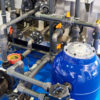The Benefits of a Bi-Carb Start up for Fresh Filled Pools
Proper Fresh Pool Fills
Last week I talked about what we believe in – our motto and pledge to you and your pool “We Do All The Work, You Have All The Fun.” It is why we do what we do at Pool Troopers. Along those lines, our Customer Service team asked me if I could further explain why we start up fresh fill pools differently than everyone else in the Florida pool industry.
Asking me to write about pools – “Please don’t throw me in the briar patch!”
Our philosophy on fresh fill pools, which are either brand new pools or pools newly filled after having been resurfaced is simple. It is based upon a few facts about cement and water 1) Cement is an alkaline product, and 2) cement takes approximately 28 days to reach its maximum hardness or to become “cured.” Admittedly cement continues to harden all its life, but it is at or near 99% hard or cured at the 28-day mark, even underwater. The rest of the fraction of a percent happens slowly over years and decades. Fact 3) Water will attempt to reach equilibrium in terms of its pH balance with its surroundings.
Given those facts about water and cement (pool plaster and even our exposed aggregate surfaces use cement in them), we feel it is vital to take special care of a freshly filled pool in the first 28 days. So what do we do that’s different? Well we work with the chemistry of the cement and water versus against it.
At this point it’s important to understand normal industry procedures. Many in our industry add acid to newly filled pool to drive down the ever rising pH of a freshly filled pool. This shows a lack of understanding why the water’s pH is rising and is not smart. A fresh filled pool has a rising pH because the pool water in trying to reach pH equilibrium with the higher pH pool plaster, and the water is leaching the carbonate alkalinity from the new pool surface.
Adding acid to the water drives the water pH lower and gives it more reason to leach more alkalinity from the new surface in the form of calcium hydroxide. The industry even has a name for this leached calcium hydroxide coming from the new pool surface- we call it plaster dust, and many companies ask you the homeowner to make sure and brush this plaster dust off the new surface every day, and be sure to add lots of acid! This is simply crazy. Plaster dust is a sign of strength leaving your pool finish and future problems.
As I said before we work with the chemical cycle of curing cement. We add bicarbonate alkalinity to the pool water in a high enough dose to make the water at least as alkaline as the new pool surface. This means no Calcium Hydroxide migrates out of the new surface and instead it is left in place to become calcium carbonate during the curing process of cement in your pool finish. By not displacing this calcium from the new surface we don’t create microscopic weak spots, which will lead to stains and rough spots, as well as discoloration. Instead we leave it in place, allowing your new pool finish to be as strong as it can be.
Preferably we add the alkalinity to the pool the same day it is filled even during filling if we can. We carefully monitor the water chemistry and check for any signs of plaster dust. We make 14-18 visits over the 28 day curing period. After about 21 days we begin to bring the water pH back into normal swim conditions and by day 28 you have the strongest pool finish you could ever have based upon the job your plastering contractor did for you. Your filter hasn’t been gummed up with gobs of “plaster dust,” and your pool finish is fully cured and as solid as it can be.
Why do we do this when everyone else in the industry doesn’t?
Simple- because it’s the right way to do it, using the proper chemistry, and it’s best for your new pool finish.
If the pool has a staining event during the 28 days curing process- what do we do?
We wait until the new pool finish is cured for 28 days and then we begin the acid based stain treatment. To treat a pool with acid during the curing process means we are creating the calcium hydroxide cycle and that weakens the finished product. Live with the surface stain for a few weeks and we will get it off after the pool cures.
What do you charge for this service?
This is a labor intensive service with 14 to as many as 20 visits to a pool over the 28 days. We charge on service clients $450.00 to $500.00 for this service. I am working with a PHD Chemist now to see if I we can shorten the rebalance period at the end of the process to try and eliminate some trips and bring the price down, but the science will need to tell us if we can lower the pH and alkalinity faster without hurting your pool finish.
Are others doing this type of start up?
Yes, I learned this process from industry friends out in California. They call it the Bi-Carb Start Up and have a white paper out about it. They have been very gracious in letting anyone use their process because it’s best for pools. However to my knowledge we have done more of these start ups than any company east of the Mississippi, well over 500 of them, and are very confident that it is the best thing for a new pool surface.
How does the process work for a client?
If a client is having their pool resurfaced, they simply call us when they sign a contract and we take care of getting the job set up. Then, they need to let us know when the pool is scheduled to be filled and update us on the schedule if it changes; after that we take care of everything until the 28 day mark.
What if a client’s pool resurface company has questions with Pool Troopers’ process?
This comes up from time to time, but we have done these jobs for most reputable companies in our market and they understand the science. Several are even offering this as part of their process now, either in house or hiring us to do the work. We are just glad it’s being done right and they are not selling clients a “Hot Start,” an industry term for dumping a bunch of acid into the pool and handing the client a brush and saying good luck- that’s not professional or good chemistry, and it’s certainly not good for the new pool finish.
If a contractor can’t get their head around what we are doing we can leave the start-up to the Contractor and just do the best we can with the pool for our client after the contractor is done. We will keep the water in the parameters the contractor requires for their warranty, if that is what the client wants us to do; our job is to give you the best service possible and take the “work” part of the pool off your shoulders so you can enjoy your pool and have fun.




